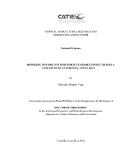| dc.description.abstract | La Fortuna, Costa Rica, is a region with high potential for becoming a sustainable destination according to international Global Sustainable Tourism Council (GSTC) standards; however, it lacks local sourcing of fresh agricultural goods, even though some of them there are locally grown. This research describes the agri-food supply chain of four basic selected products (cassava, papaya, plantain and taro) in the region and addresses governance mechanisms, price gaps and overall limitations of an effective supply chain.
Price gaps between farm-gate prices received by small- and medium-scale farmers (SMFs) and purchase prices by restaurants demonstrate large differences, ranging from 41% in the case of plantain to 333% in the case of papaya, possibly representing significant additional income for farmers. Governance structures are led by buyers, with farmers playing a price-taker role. Therefore, instead of participating as active members of the supply chain in terms of strategic decision making, they are restricted to the production stages of the supply chain.
Small- and medium-scale farmers represent a vulnerable sector of most economies. Since there is often a close relationship between agriculture and poverty, development agendas frequently encourage the capacity of smallholders to identify and produce for niche markets to obtain higher prices and therefore, improve their standards of living.
A total of 108 small- and medium-scale farmers were interviewed in La Fortuna, a northern region of Costa Rica, to analyze their supply chain structure, to obtain their perception on fairness of prices and to analyze their partner-selection strategies and overall possibility to strive for sustainable supply-chain management. From the demand perspective, 80 tourists were also interviewed to assess their willingness to pay for sustainable products and organic food.
Results show farmers’ perceptions of fairness of prices are neither dependent on farmers’ education nor the type of negotiation (written contract, verbal contract or no contract) but on the type of buyer. Kruskall Wallis tests showed significant differences in perceptions only dependent on the type of buyer (p-values =0.033, 0.004, 0.043) for three of the four variables of analysis, suggesting there are important differences in their perceptions of fair distribution and prices according to their supply chain partner.
To address selection of supply chain partners, 12 variables were considered for analysis, based on an extensive literature review on small- and medium-scale farmers, high value-added supply chains and supply-chain-partner selection in agri-food supply chains. A fuzzy Technique for Order of Preference by Similarity to Ideal Solution (TOPSIS) was conducted; this multi-criteria decision-making approach was used to analyze the selection of partners from the perspective of small/medium farmers and from the perspective of restaurants in order to provide insight in addressing local sourcing problems. Results from Fuzzy TOPSIS show that it is more convenient to both farmers and restaurants to trade with each other rather than other actors, according to results from the proposed method; closeness coefficients (CCs) from the restaurants’ perspectives, were better for farmers (0.56), while intermediaries received a lower calcification (0.46), which was unexpected since most restaurants (63%) source from intermediaries.
From the farmers’ perspectives, their best alternatives are to sell to restaurants (0.44) or to local markets (0.44), while the lowest ranked options were small local markets (0.37) and intermediaries (0.38). Nonetheless, CCs are low on both sides.
Lack of partnership with small- and medium-scale farmers in food supply chains is a common issue in La Fortuna. A constrained analytical hierarchy process (AHP) was performed to obtain weights of determinant variables for trading, which is important so that the selection of supply-chain partners can be better understood. A gap analysis containing both weights (by AHP) and alternative ranking (by TOPSIS) was done to obtain the distance between two fuzzy numbers: from the perspective of farmers and from the perspective of restaurant decision makers. This gap analysis indicates how much distance there is between the perceptions of both groups in each of the 12 selected variables.
Results reveal there are some similarities between the perceptions of farmers and restaurant managers regarding price, quality and transparency of transactions; however, there are other aspects such as organic production and environmental practices that are not aligned in relative importance among them. Results suggest a relationship between the gap and the experience of farmers and restaurant owners or decision makers(managers); when farmers have 15 years or more of experience and restaurant owners more than 10 years, their gap closes when compared to the distance between inexperienced farmers and restaurants; this gap ranges from 0.55 for experienced actors to 0.34 for inexperienced actors.
Suggestions for improving trading mechanisms among small- and medium-scale farmers with the tourism sector tilt toward installing farmer leaders in the region who can teach other farmers how to improve in terms of production and market access. The lack of farmers’ organizations is a restriction when considering options such as cooperatives to lead the supply chain; in addition, certification mechanisms are nonexistent for these farmers, therefore aiming for coordination from this perspective would not be possible, at least in the short run.
Lack of information about farmers’ locations and accurate estimation of population size was a challenge. Multiple visits to the region were needed simply to locate farmers and to estimate the most important regions to visit; sample sizes for tourists would need to be increased to have accurate estimates.
Responses from farmers were difficult to obtain and questions needed to be revised and re-formulated; comparisons of relative importance of variables were not understandable to farmers and therefore a workshop was conducted to address relative importance visually. There were significant differences in perceptions for selected variables when participants were asked individually and when these were addressed in a group. Further research is necessary to have more conclusive estimates and conclusions. | es_ES |


